Combined Coherent and Non-Coherent Long-Time Integration Method for High-Speed Target Detection Using High-Frequency Radar
Abstract
:1. Introduction
- First-order motion: The first-order Taylor series model is used to express motion with constant radial speed, in which case only RM occurs and DFM does not exist. Typical methods include keystone transform (KT) [8,9,10], Radon Fourier transform (RFT) [11], axis rotation moving target detection (AR-MTD) [12], etc. The KT eliminates RM by re-scaling the slow time axis. The RFT corrects RM via joint two-dimensional searching for the target’s range and speed. The AR-MTD method eliminates RM by rotating the echo locations and achieving energy integration via Fourier transform.
- Second-order motion: The second-order model is used to express motion with constant acceleration, generating second-order RM and first-order DFM. The second-order KT (SKT) [13] can correct RM, and the fractional Radon transform (FRFT) can eliminate DFM. Hence, the combined SKT-FRFT was proposed [14]. This method is computationally efficient but limited in performance compared with simultaneous RM-DFM correction algorithms, such as Radon FRFT (RFRFT) [15], Radon linear canonical transform (RLCT) [16], and Radon Lv’s distribution (RLVD) [17].
- Third-order motion: Similarly, the third-order model corresponds to motion with a constant radial jerk, which will cause additional third-order RM and second-order DFM. The solution can be extended from the first- and second-order cases. For example, RFRFT was extended to the Radon-fractional ambiguity function (RFRAF) by employing a long-time instantaneous autocorrelation function [18]. Xu et al. [19] proposed the generalized RFT (GRFT) method based on RFT by introducing multi-dimensional joint searching. Theoretically, GRFT can apply to arbitrary motion types by adding more search parameters, but the computation complexity increases exponentially with the number of parameters. Fast calculation methods of GRFT [20] have been developed.
2. Problem Formulation
2.1. Signal Model
2.2. SNR Fluctuation
3. Long-Time Integration via AFS-GRFT Method
3.1. Definition of GRFT
3.2. Amplitude Fluctuation Suppression Based on Non-Coherent Integration
3.3. Block Diagram
3.3.1. Stage 0: Pre-Processing
3.3.2. Stage 1: GRFT
3.3.3. Stage 2: AFS Based on Non-Coherent Integration
4. Numerical Simulation
4.1. Metrics Definition
4.2. Algorithm Flow Validation
4.2.1. dB
4.2.2. dB
4.3. Analysis of Detection Probability and Search Accuracy
4.3.1. Detection Probability
4.3.2. Search Accuracy
5. Experimental Results
5.1. Single Target Detection Results
5.1.1. Data #1
5.1.2. Data #4, #5, and #6
5.2. Multi-Target Detection Results
5.3. Discussion
5.3.1. Computation Complexity
5.3.2. Complex Multi-Target Scenario
5.3.3. Complex Interference and Clutter
6. Conclusions
Author Contributions
Funding
Data Availability Statement
Acknowledgments
Conflicts of Interest
References
- Khan, R.; Gamberg, B.; Power, D.; Walsh, J.; Dawe, B.; Pearson, W.; Millan, D. Target detection and tracking with a high frequency ground wave radar. IEEE J. Ocean. Eng. 1994, 19, 540–548. [Google Scholar] [CrossRef]
- Khan, R.H.; Power, D. Aircraft detection and tracking with high frequency radar. In Proceedings of the International Radar Conference, Alexandria, VA, USA, 8–11 May 1995; pp. 44–48. [Google Scholar]
- Earl, G.; Ward, B. The frequency management system of the Jindalee over-the-horizon backscatter HF radar. Radio Sci. 1987, 22, 275–291. [Google Scholar] [CrossRef]
- Francis, D.B.; Cervera, M.A.; Frazer, G.J. Performance prediction for design of a network of skywave over-the-horizon radars. IEEE Aerosp. Electron. Syst. Mag. 2017, 32, 18–28. [Google Scholar] [CrossRef]
- Anderson, S. Counter-OTHR 101: Low observability at HF. In Proceedings of the International Conference on Radar Systems (RADAR 2022), Edinburgh, UK, 24–27 October 2022; pp. 405–410. [Google Scholar]
- Tao, R.; Zhang, N.; Wang, Y. Analysing and compensating the effects of range and Doppler frequency migrations in linear frequency modulation pulse compression radar. IET Radar Sonar Navig. 2011, 5, 12–22. [Google Scholar]
- Lu, B.; Wen, B.; Tian, Y.; Wang, R. A vessel detection method using compact-array HF radar. IEEE Geosci. Remote Sens. Lett. 2017, 14, 2017–2021. [Google Scholar] [CrossRef]
- Li, G.; Xia, X.-G.; Peng, Y.-N. Doppler keystone transform: An approach suitable for parallel implementation of SAR moving target imaging. IEEE Geosci. Remote Sens. Lett. 2008, 5, 573–577. [Google Scholar] [CrossRef]
- Perry, R.; Dipietro, R.; Fante, R. SAR imaging of moving targets. IEEE Trans. Aerosp. Electron. Syst. 1999, 35, 188–200. [Google Scholar] [CrossRef]
- Zhu, D.; Li, Y.; Zhu, Z. A keystone transform without interpolation for SAR ground moving-target imaging. IEEE Geosci. Remote Sens. Lett. 2007, 4, 18–22. [Google Scholar] [CrossRef]
- Xu, J.; Yu, J.; Peng, Y.-N.; Xia, X.-G. Radon-Fourier transform for radar target detection, I: Generalized Doppler filter bank. IEEE Trans. Aerosp. Electron. Syst. 2011, 47, 1186–1202. [Google Scholar] [CrossRef]
- Rao, X.; Tao, H.; Su, J.; Guo, X.; Zhang, J. Axis rotation MTD algorithm for weak target detection. Digit. Signal Process. 2014, 26, 81–86. [Google Scholar] [CrossRef]
- Kirkland, D. Imaging moving targets using the second-order keystone transform. IET Radar Sonar Navig. 2011, 5, 902–910. [Google Scholar] [CrossRef]
- Sun, G.; Xing, M.-D.; Wang, Y.; Zhou, F.; Wu, Y.; Bao, Z. Improved ambiguity estimation using a modified fractional Radon transform. IET Radar Sonar Navig. 2011, 5, 489–495. [Google Scholar] [CrossRef]
- Chen, X.; Guan, J.; Liu, N.; He, Y. Maneuvering target detection via Radon-fractional Fourier transform-based long-time coherent integration. IEEE Trans. Signal Process. 2014, 62, 939–953. [Google Scholar] [CrossRef]
- Chen, X.; Guan, J.; Liu, N.; Zhou, W.; He, Y. Detection of a low observable sea-surface target with micromotion via the Radon-linear canonical transform. IEEE Geosci. Remote Sens. Lett. 2013, 11, 1225–1229. [Google Scholar] [CrossRef]
- Li, X.; Cui, G.; Yi, W.; Kong, L. Coherent integration for maneuvering target detection based on Radon-Lv’s distribution. IEEE Signal Process. Lett. 2015, 22, 1467–1471. [Google Scholar] [CrossRef]
- Chen, X.; Huang, Y.; Liu, N.; Guan, J.; He, Y. Radon-fractional ambiguity function-based detection method of low-observable maneuvering target. IEEE Trans. Aerosp. Electron. Syst. 2015, 51, 815–833. [Google Scholar] [CrossRef]
- Xu, J.; Xia, X.-G.; Peng, S.-B.; Yu, J.; Peng, Y.-N.; Qian, L.-C. Radar maneuvering target motion estimation based on generalized Radon-Fourier transform. IEEE Trans. Signal Process. 2012, 60, 6190–6201. [Google Scholar]
- Ding, Z.; Liu, S.; Li, Y.; You, P.; Zhou, X. Parametric translational compensation for isar imaging based on cascaded subaperture integration with application to asteroid imaging. IEEE Trans. Geosci. Remote Sens. 2022, 60, 1–17. [Google Scholar] [CrossRef]
- Li, X.; Cui, G.; Yi, W.; Kong, L. A fast maneuvering target motion parameters estimation algorithm based on ACCF. IEEE Signal Process. Lett. 2014, 22, 270–274. [Google Scholar] [CrossRef]
- Cui, G.; DeMaio, A.; Piezzo, M. Performance prediction of the incoherent radar detector for correlated generalized Swerling-chi fluctuating targets. IEEE Trans. Aerosp. Electron. Syst. 2013, 49, 356–368. [Google Scholar] [CrossRef]
- Zhou, X.; Qian, L.; Ding, Z.; Xu, J.; Liu, W.; You, P.; Long, T. Radar detection of moderately fluctuating target based on optimal hybrid integration detector. IEEE Trans. Aerosp. Electron. Syst. 2018, 55, 2408–2425. [Google Scholar] [CrossRef]
- Zhang, Z.; Liu, N.; Hou, Y.; Zhang, S.; Zhang, L. A coherent integration segment searching based GRT-GRFT hybrid integration method for arbitrary fluctuating target. Remote Sens. 2022, 14, 2695. [Google Scholar] [CrossRef]
- Shen, Y.; Zhang, N.; Liu, Y. New waveform with both high range resolution and long coherent integration time in a HF radar. In Proceedings of the International Radar Conference, Beijing, China, 8–10 October 1996; pp. 285–288. [Google Scholar]
- Shen, Y.; Liu, Y.; Wu, A. Coherent phase-coded pulse train with Doppler cascade-processing for detection of aircraft target in a HF radar. J. Syst. Eng. Electron. 1999, 10, 50–56. [Google Scholar]
- Dzvonkovskaya, A.; Rohling, H. Fast-moving target observation using high-frequency surface wave radar. In Proceedings of the 2014 International Radar Conference, Lille, France, 13–17 October 2014; pp. 1–4. [Google Scholar]
- Trueman, C.W.; Kubina, S.J.; Mishra, S.R.; Larose, C. Radar cross-section of a generic aircraft at HF frequencies. Can. J. Electr. Comput. Eng. 1993, 18, 59–64. [Google Scholar] [CrossRef]
- Chen, X.; Yu, X.; Huang, Y.; Guan, J. Adaptive clutter suppression and detection algorithm for radar maneuvering target with high-order motions via sparse fractional ambiguity function. IEEE J. Sel. Top. Appl. Earth Obs. Remote Sens. 2020, 13, 1515–1526. [Google Scholar] [CrossRef]
- Gurgel, K.-W.; Barbin, Y.; Schlick, T. Radio frequency interference suppression techniques in FMCW modulated HF radars. In Proceedings of the OCEANS 2007-Europe, Aberdeen, UK, 18–21 June 2007; pp. 1–4. [Google Scholar]
- Zhou, H.; Wen, B.; Wu, S. Dense radio frequency interference suppression in HF radars. IEEE Signal Process. Lett. 2005, 12, 361–364. [Google Scholar] [CrossRef]
- Li, X.; Sun, Z.; Yeo, T.S.; Zhang, T.; Yi, W.; Cui, G.; Kong, L. STGRFT for detection of maneuvering weak target with multiple motion models. IEEE Trans. Signal Process. 2019, 67, 1902–1917. [Google Scholar] [CrossRef]
- Tsao, J.; Steinberg, B.D. Reduction of sidelobe and speckle artifacts in microwave imaging: The CLEAN technique. IEEE Trans. Antennas Propag. 1988, 36, 543–556. [Google Scholar] [CrossRef]
- Misiurewicz, J.; Kulpa, K.S.; Czekala, Z.; Filipek, T.A. Radar detection of helicopters with application of CLEAN method. IEEE Trans. Aerosp. Electron. Syst. 2012, 48, 3525–3537. [Google Scholar] [CrossRef]
- Yu, J.; Xu, J.; Peng, Y.-N.; Xia, X.-G. Radon-Fourier transform for radar target detection (III): Optimality and fast implementations. IEEE Trans. Aerosp. Electron. Syst. 2012, 48, 991–1004. [Google Scholar] [CrossRef]
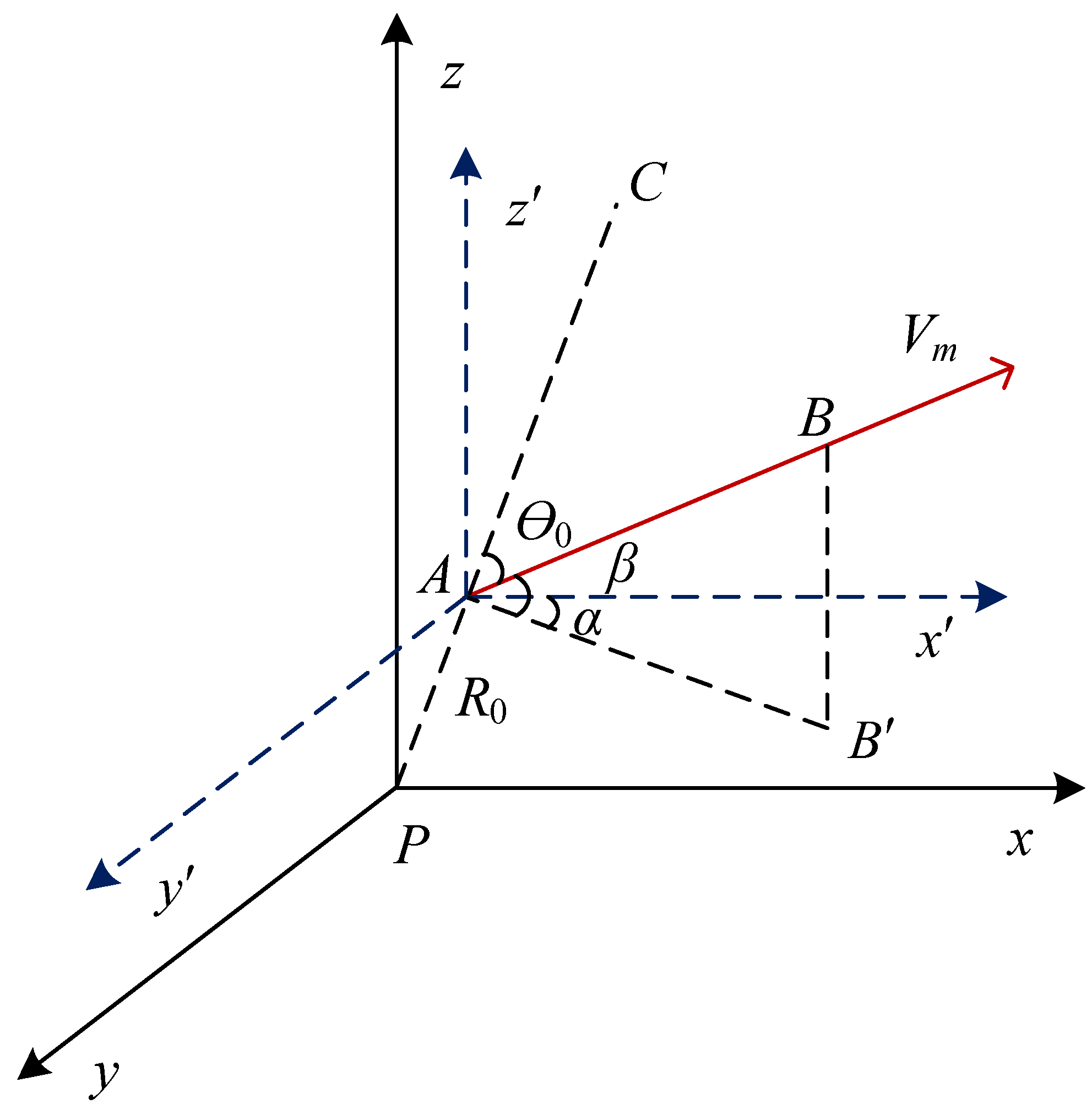
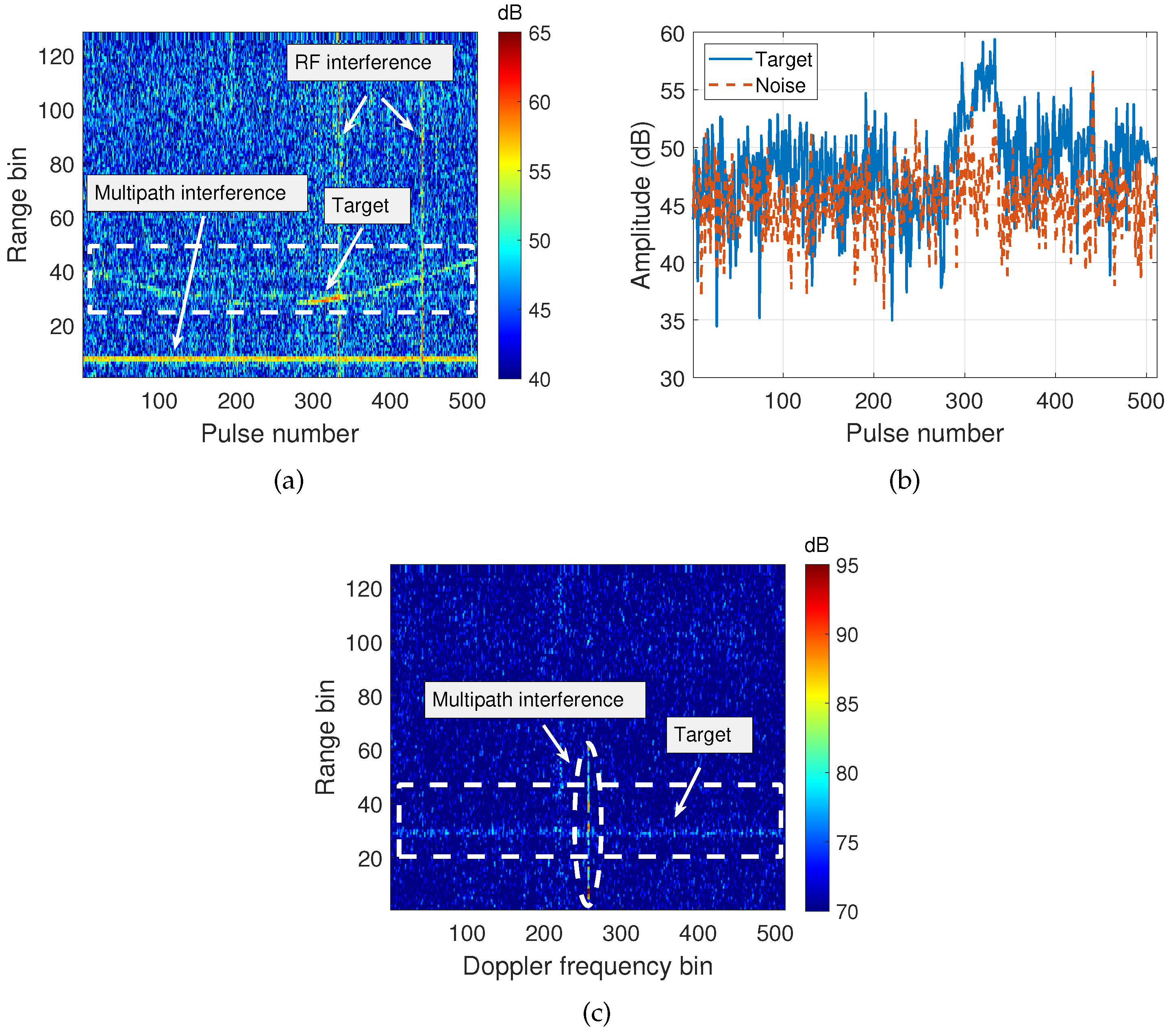
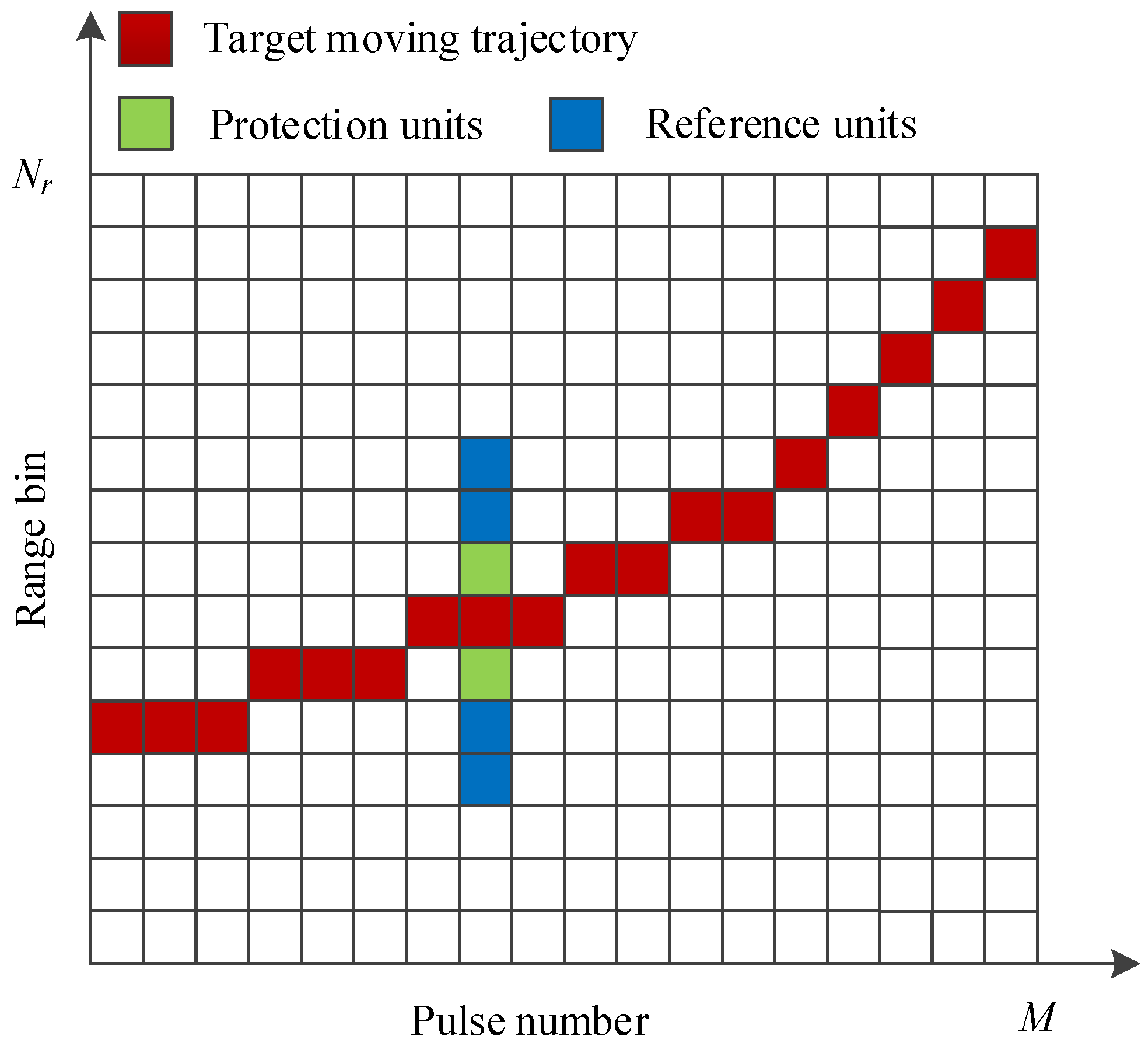




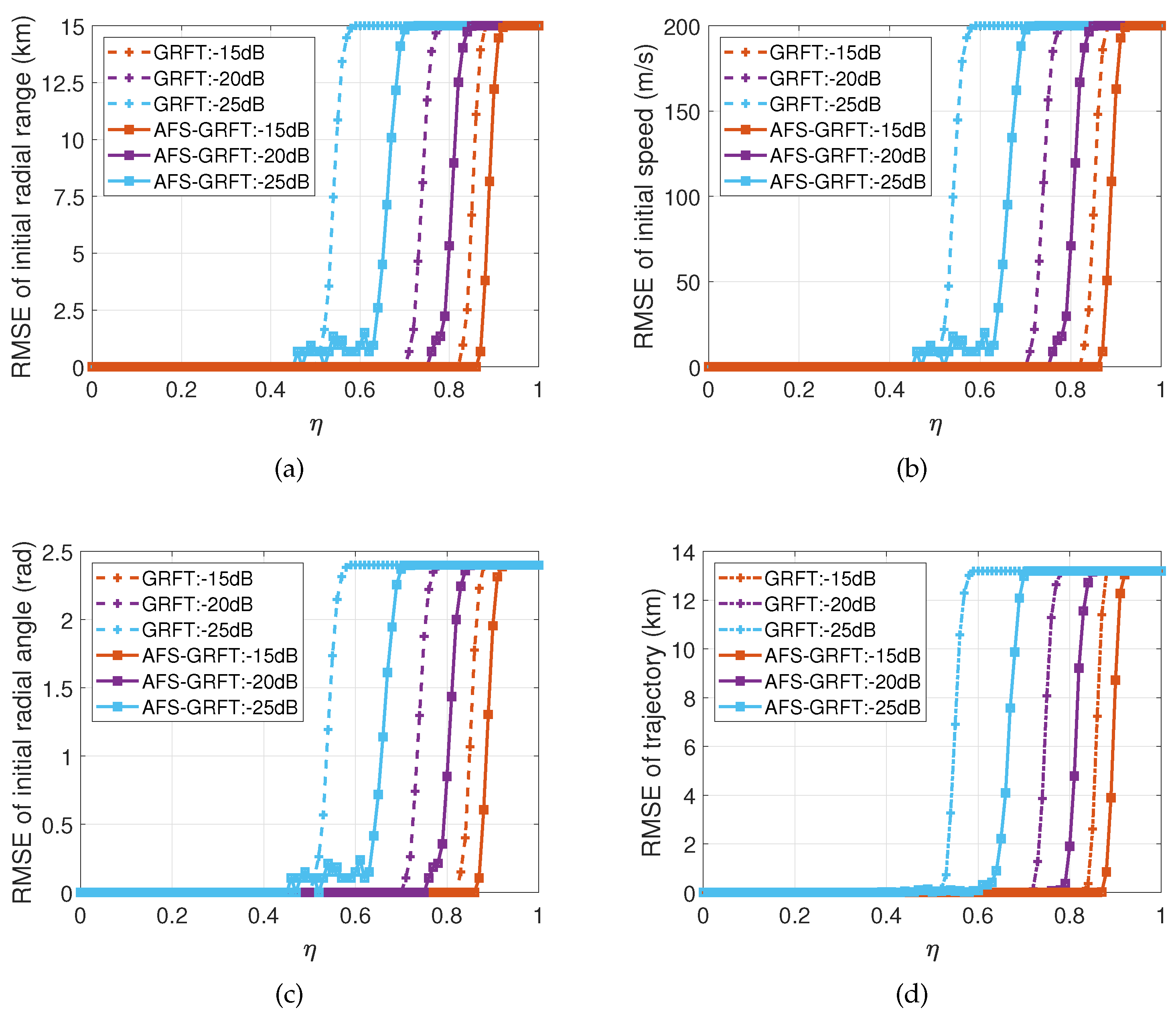
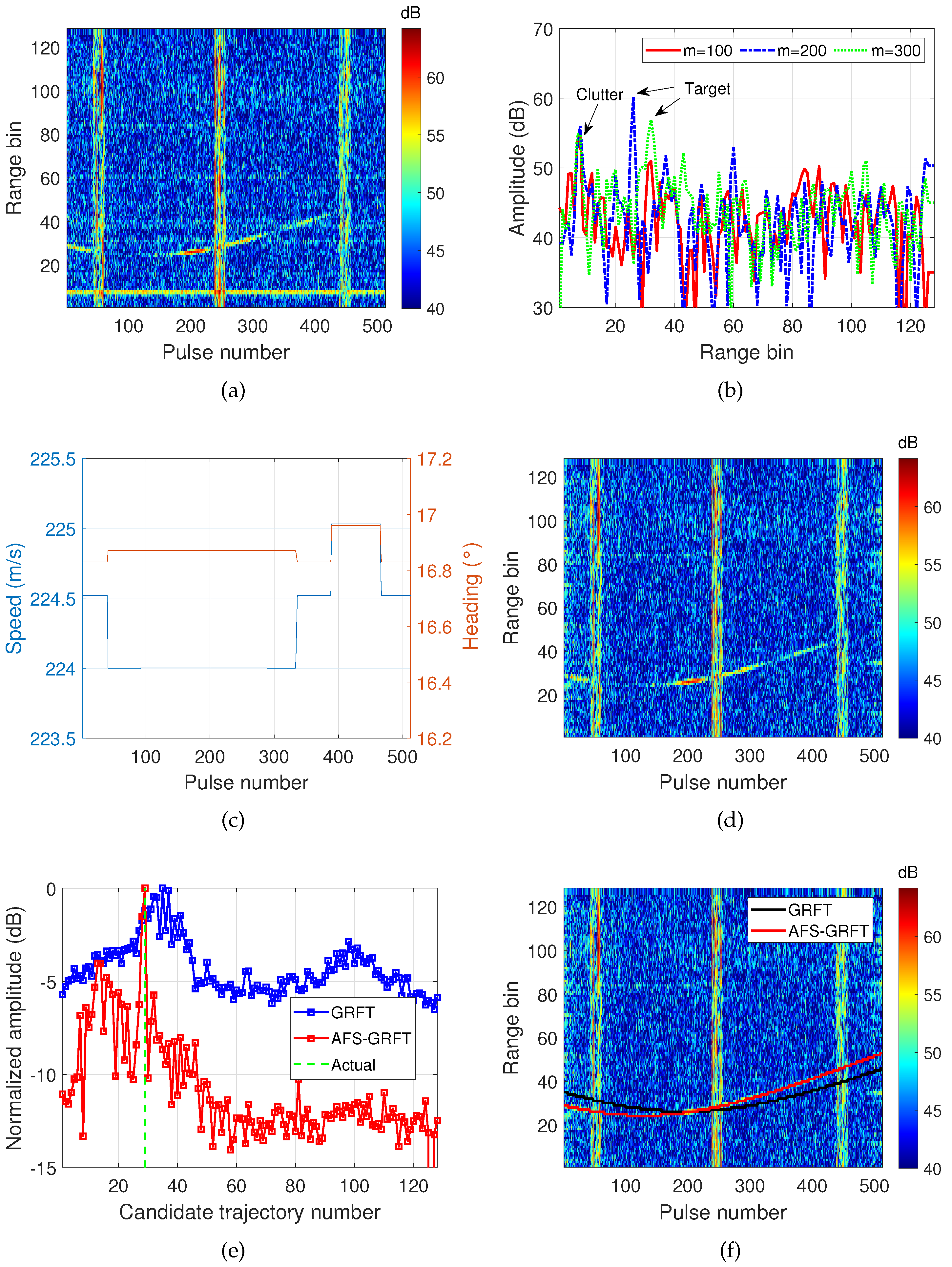

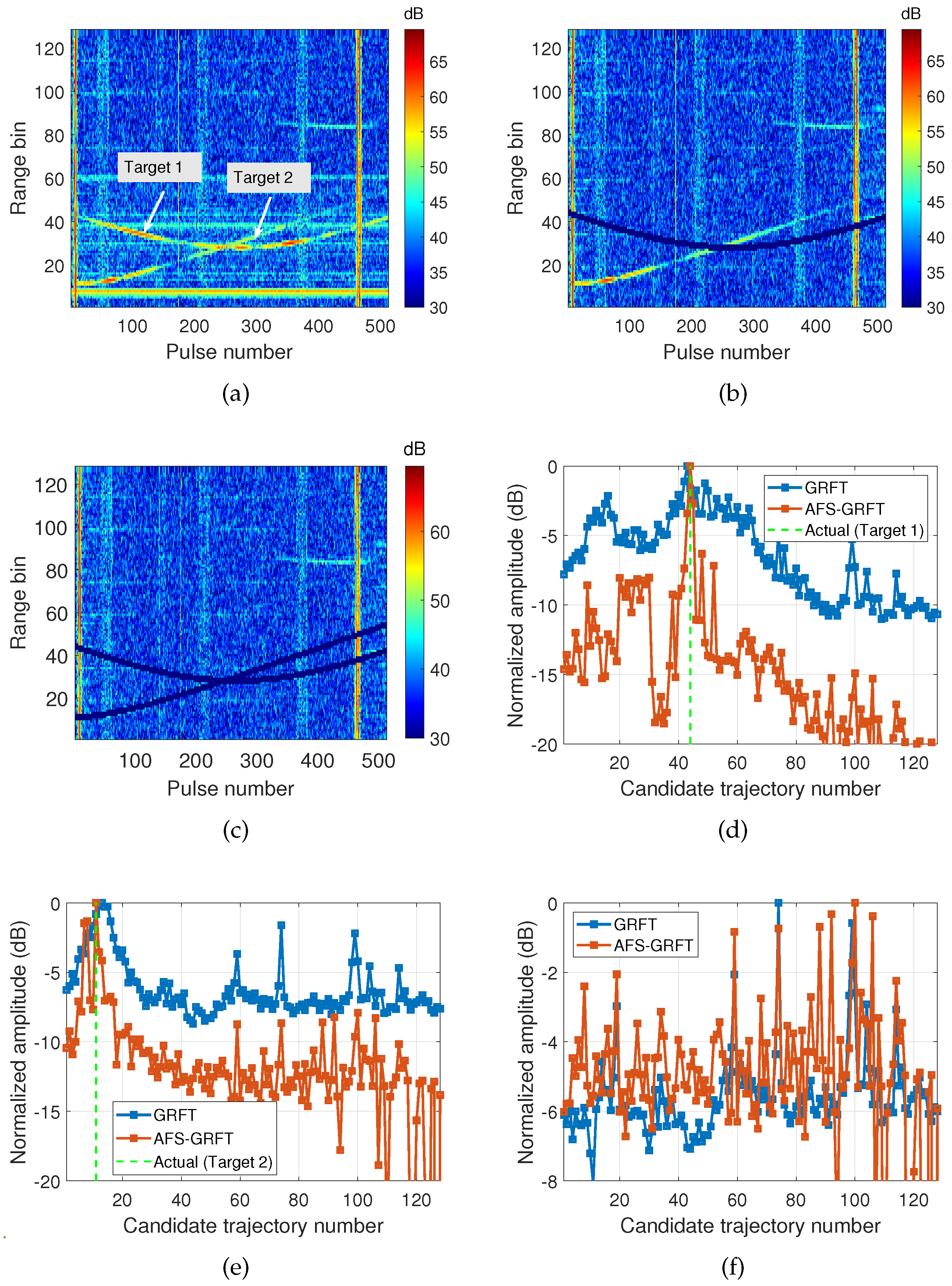
| Type | Parameters | Symbol | Value |
|---|---|---|---|
| Radar | Range resolution | 0.5 km | |
| Velocity resolution | 0.05 m/s | ||
| Sweep interval | 0.27 s | ||
| Number of sweeps | M | 512 | |
| CIT | 138.24 s | ||
| Target | Initial radial range | 15 km | |
| Initial speed | 200 m/s | ||
| Initial radial angle | 2.4 rad | ||
| Search | Initial radial range | 0 : 0.5 : 64 km | |
| Initial speed | 3 : 0.05 : 300 m/s | ||
| Initial radial angle | 0 : : 3.14 rad |
| ADS-B | GRFT | AFS-GRFT | |||||||||||||||
|---|---|---|---|---|---|---|---|---|---|---|---|---|---|---|---|---|---|
| ID | ICAO Address | (dB) | (m/s) | (km) | (rad) | (m/s) | (km) | (rad) | RMSE of (km) | (m/s) | (km) | (rad) | RMSE of (km) | ||||
| 1 | 780EB7 | 0.62 | −12.7 | 224.5 | 14.26 | 2.12 | 220.2 | 17.5 | 2.30 | 1.79 | 229.0 | 14.5 | 2.16 | 0.49 | |||
| 2 | 78100B | 0.47 | −12.4 | 235.1 | 25.32 | 2.51 | 195.8 | 24.5 | 2.48 | 0.79 | 244.9 | 26.0 | 2.52 | 0.37 | |||
| 3 | 781279 | 0.27 | −11.5 | 170.3 | 11.05 | 2.47 | 165.7 | 12.5 | 2.51 | 1.23 | 179.4 | 11.5 | 2.50 | 0.32 | |||
| 4 | 7BB0E9 | 0.64 | −12.1 | 129.7 | 13.57 | 1.95 | 144.7 | 13.5 | 2.05 | 0.34 | 144.7 | 13.5 | 2.05 | 0.34 | |||
| 5 | 7805AA | 0.73 | −17.2 | 238.3 | 9.43 | 0.61 | 12.5 | 10.0 | 1.57 | 11.25 | 229.1 | 7.5 | 0.53 | 0.94 | |||
| 6 | 79803F | 0.75 | −16.2 | 232.2 | 20.11 | 1.51 | 34.5 | 20.5 | 1.58 | 11.63 | 230.4 | 20.5 | 1.58 | 0.71 | |||
| Target | ADS-B | GRFT | AFS-GRFT | |||||||||||
|---|---|---|---|---|---|---|---|---|---|---|---|---|---|---|
(m/s) | (km) | (rad) | (m/s) | (km) | (rad) | RMSE of (km) | (m/s) | (km) | (rad) | RMSE of (km) | ||||
| 1 | 230.0 | 21.67 | 2.43 | 236 | 22.0 | 2.45 | 0.43 | 236 | 22.0 | 2.45 | 0.43 | |||
| 2 | 185.5 | 5.88 | 1.85 | 190.0 | 6.5 | 1.51 | 0.48 | 192 | 5.5 | 1.87 | 0.39 | |||
Disclaimer/Publisher’s Note: The statements, opinions and data contained in all publications are solely those of the individual author(s) and contributor(s) and not of MDPI and/or the editor(s). MDPI and/or the editor(s) disclaim responsibility for any injury to people or property resulting from any ideas, methods, instructions or products referred to in the content. |
© 2024 by the authors. Licensee MDPI, Basel, Switzerland. This article is an open access article distributed under the terms and conditions of the Creative Commons Attribution (CC BY) license (https://creativecommons.org/licenses/by/4.0/).
Share and Cite
Liu, G.; Tian, Y.; Wen, B.; Liu, C. Combined Coherent and Non-Coherent Long-Time Integration Method for High-Speed Target Detection Using High-Frequency Radar. Remote Sens. 2024, 16, 2139. https://doi.org/10.3390/rs16122139
Liu G, Tian Y, Wen B, Liu C. Combined Coherent and Non-Coherent Long-Time Integration Method for High-Speed Target Detection Using High-Frequency Radar. Remote Sensing. 2024; 16(12):2139. https://doi.org/10.3390/rs16122139
Chicago/Turabian StyleLiu, Gan, Yingwei Tian, Biyang Wen, and Chen Liu. 2024. "Combined Coherent and Non-Coherent Long-Time Integration Method for High-Speed Target Detection Using High-Frequency Radar" Remote Sensing 16, no. 12: 2139. https://doi.org/10.3390/rs16122139






